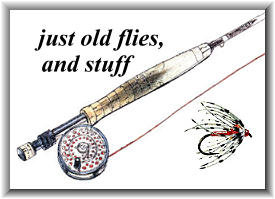Mary Orvis Marbury's turn of the century
book Favorite Flies and their Histories
is an unending source of fascinating anecdotes
and fly fishing stories, and while reading them,
you begin to get the idea that not much has changed
in 100 years or so. But when you get to the Western
part of the book, there is a big departure. This is
the wild west of Buffalo Bill that is being described
in letters, and a yarn spun in a letter she received
from "Tamarrack" really gives you the flavor:
"In October, 1877, while accompanying an
expedition to the far West, we marched overland
from Corinne, Utah, to Missoula, Montana, a
distance of six hundred miles. We were forty-one
days on the road, and suffered some hardships,
including a snow blockade of five days on the
main divide of the Rockies, where the thermometer
fell from forty above to twenty below zero in
twelve hours. For the benefit of those who do
not know, I will say that all marches are regulated
by wood and water, especially the latter. Our fifth
camp was on a beautiful little stream about twenty
feet wide, which wound and twisted in nearly all
direction[s] in its efforts to reach the Snake River,
and from there to the Pacific.
As soon as the tents were pitched we rushed to
the stream, clear as crystal, for water; and oh!
The beauty of the sight! Trout of all sizes, from
the two-pounder on down, were literally swarming
in a pool. When I was a little boy, I heard my
father speak about catching trout with a piece
of red flannel. My boyhood recollections stood
me in good place. Running to my tent, I got a
piece of flannel, tied it on the hook, and made
my first cast."
Tamarrack succeeds in landing his first trout, an
eight incher, and then goes on to fabricate his
first fly rod from a sapling. It is the first rod
in a series, each new design improving on the one
before. These days, our idea of hardships endured
on fishing trips involve your rod getting lost at
the airport, your having to use your buddy's for
a day, and the water at the motel being a little
harder than you're used to. I'd say a 600 mile march
in the Rockies in winter to get to the stream is a
REAL hardship. Anyway, this week's fly evokes those
days. It was sent to Mary Orvis Marbury by a fisherman
living in Laramie City, Wyoming. It had no name, but
was reportedly successful in that area.
She goes on to say "We copied the fly, and in order
to distinguish it and locate its usefulness called
it the Laramie because it first came to us with its
record from that place. Since then it has been much
used in the far West, and seems adapted to the streams
of that section of the country."
The Laramie survived at least up to the publication
of Ray Bergman's Trout in 1938, where
it can be found with many other wet flies in use at
that time. I've done the Mary Orvis Marbury version,
which has a short tail of yarn, rather than the
longer tail found in the Ray Bergman book.
Here's the recipe for The Laramie:
~ Eric Austin
Credits: Favorite Flies and Their
Histories by Mary Orvis Marbury;
Trout by Ray Bergman.
|

